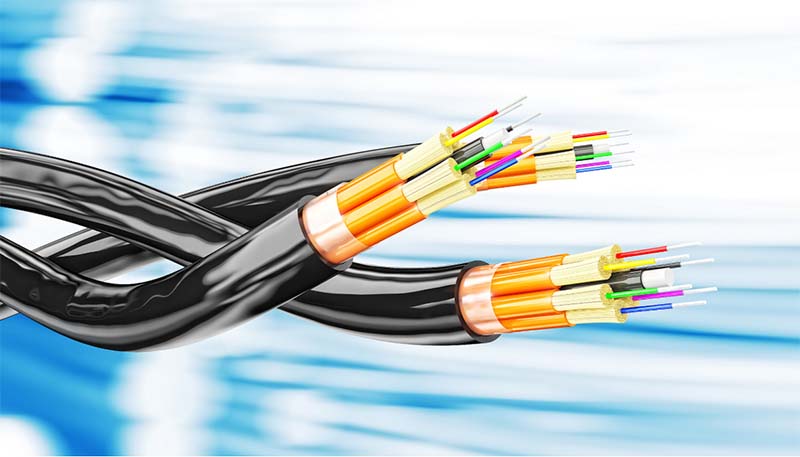With the rapid advancement of cloud computing, 5G networks, and artificial intelligence (AI), global data traffic is experiencing exponential growth. Industry forecasts predict that by 2025, annual internet traffic will reach thousands of zettabytes (ZB), placing unprecedented demands on the bandwidth and efficiency of optical fiber communication networks.
Simultaneously, operators and enterprises face immense pressure to reduce per-bit transmission costs, rendering traditional optical communication technologies insufficient.
Against this backdrop, the emergence of C+L band technology has become a pivotal innovation in the field. By integrating the C band (1530-1565 nm) and L band (1565-1625 nm) and leveraging wavelength division multiplexing (WDM), C+L band technology significantly expands the usable bandwidth of optical fibers, providing robust support for the evolution of all-optical networks.
Technical Principles of C+L Band and WDM
The foundation of C+L band technology lies in expanding the usable spectral range of optical fiber communication. The C band (1530-1565 nm), with its low attenuation (approximately 0.2 dB/km), has long been the primary wavelength range for optical communication, but its bandwidth of about 4 THz struggles to meet modern high-capacity demands.
The L band (1565-1625 nm) adds another approximately 4 THz of usable bandwidth. Together, they can boost the theoretical capacity of a single fiber from 25 Tbps to over 50 Tbps. Wavelength division multiplexing (WDM), particularly dense wavelength division multiplexing (DWDM), capitalizes on the wide spectrum of the C+L band by transmitting multiple optical signals at different wavelengths over the same fiber.
For instance, modern DWDM systems can support up to 96 or more channels within the C+L band, with per-channel rates reaching 400 Gbps or even 800 Gbps.
Coherent detection technology is another critical enabler of C+L band performance. Unlike traditional intensity-based detection, coherent detection captures both the amplitude and phase of optical signals, utilizing digital signal processing (DSP) to effectively compensate for dispersion and nonlinear effects in the fiber.
With phase modulation formats such as QPSK or 16QAM, coherent systems can achieve longer transmission distances—typically over 1000 km without regeneration—even under lower optical signal-to-noise ratios (OSNR). Additionally, coherent technology enhances noise resilience, making C+L band systems particularly effective in long-haul backbone networks. These technical advancements provide a solid foundation for efficient optical communication.
Evolution of All-Optical Networks and the Role of C+L Band
All-optical networks refer to systems where signals are processed entirely in the optical domain, eliminating the frequent optical-to-electrical conversions of traditional hybrid networks. The core of all-optical networks lies in flexible and efficient optical-layer scheduling, a process significantly accelerated by the introduction of C+L band technology.
Compared to traditional C-band systems, the high bandwidth of the C+L band doubles single-fiber capacity, supporting node throughputs of tens of Tbps and meeting the needs of data center interconnects (DCI) and 5G transport networks.
Furthermore, low-loss fibers (e.g., ITU-T G.654.E, with an attenuation of about 0.16 dB/km) paired with the C+L band reduce the reliance on optical amplifiers and repeaters.
In all-optical network architectures, reconfigurable optical add-drop multiplexers (ROADM) and optical cross-connects (OXC) are essential components. The C+L band enables higher-dimensional ROADM designs, such as scaling from 8-degree to 20-degree or even 32-degree configurations, allowing dynamic wavelength allocation and flexible routing. OXC systems, by integrating more optical ports and wavelength selective switches (WSS), support cross-connect capacities of hundreds of Tbps.
This high-dimensional, fully optical scheduling capability not only enhances network scalability but also provides the hardware foundation for AI-driven intelligent optimization. It is evident that the C+L band is driving all-optical networks from theoretical concepts to widespread commercial deployment.
Revolutionary Breakthroughs in Cost and Performance
The adoption of C+L band technology delivers substantial cost and performance benefits. From a cost perspective, its high bandwidth reduces the need for parallel fiber deployments. For example, a traditional C-band system might require four fibers to achieve 100 Tbps capacity, whereas a C+L band system can accomplish the same with just two or even one fiber.
This reduction lowers fiber deployment and maintenance costs while minimizing the number of repeaters, further cutting operational expenses. Industry estimates suggest that C+L band systems can reduce per-bit transmission costs by approximately 30%, with particularly pronounced savings in long-haul backbone networks.
On the performance front, the C+L band, combined with coherent detection, significantly enhances transmission capabilities. For a 400 Gbps single-wavelength signal, C+L band systems can maintain stable OSNR over 2000 km, whereas traditional C-band systems may require signal regeneration after 1000 km.
Moreover, the wide spectrum of the C+L band supports higher-order modulation formats (e.g., 64QAM), paving the way for single-channel rates to transition from 400 Gbps to 800 Gbps or even 1 Tbps.
In terms of energy efficiency, the synergy between new optical amplifiers (e.g., Raman amplifiers) and the C+L band reduces system power consumption by about 20%, aligning with the trend toward green communication. These advancements collectively constitute a revolution in the cost and performance of optical fiber communication.
Application Cases and Industry Impact
C+L band technology has entered the phase of practical deployment worldwide. For instance, China Telecom completed a backbone network upgrade in 2024 using C+L band technology, boosting single-fiber capacity to 48 Tbps across multiple data center nodes in East China.
In early 2025, Japan’s NTT announced a successful test with Cisco, deploying a C+L band system to support 400 Gbps transmission from Tokyo to Osaka. These cases demonstrate that C+L band technology is not only suitable for national backbone networks but also excels in metropolitan area networks and data center interconnects.
In 5G transport networks and AI computing networks, the C+L band plays a vital role. The low-latency and high-bandwidth demands of 5G fronthaul and midhaul/backhaul networks are met through DWDM-enabled multi-service transport, ensuring efficient connectivity between base stations and core networks.
For AI computing networks, the ultra-high bandwidth of the C+L band provides reliable transmission for distributed training clusters. At the industry level, the surge in demand for optical modules, amplifiers, and ROADM equipment has spurred rapid technological iterations across the supply chain.
Future Outlook and Challenges
Looking ahead, C+L band technology lays a strong foundation for optical fiber communication to advance toward 800 Gbps and 1 Tbps eras. With further optimization of modulation formats and DSP advancements, single-fiber capacity could exceed 100 Tbps, supporting the needs of 6G networks and next-generation internet. Additionally, the integration of C+L band technology with emerging fields like quantum communication and silicon photonics holds promise. For example, overlaying quantum key distribution (QKD) within the C+L band could enable ultra-secure communication networks.
However, challenges remain. Nonlinear effects in fibers (e.g., four-wave mixing) may limit the application of high-order modulation, necessitating solutions through novel fibers or algorithmic compensation. Compatibility with existing network equipment and initial deployment costs could also slow adoption. Addressing these hurdles requires collaborative innovation across the industry to align technological progress with market demands.
Natural Integration of HTF
Amid the rapid evolution of optical fiber communication, the role of specialized suppliers is indispensable. For instance, HTF, a professional provider of optical fiber products and WDM system solutions, leverages a team with over a decade of experience in optical communication R&D to deliver comprehensive transmission solutions.
HTF is dedicated to helping customers build, connect, and optimize their optical infrastructure, serving global data centers, 5G networks, cloud computing, and metropolitan networks. Notably, HTF’s HT6000 system—a compact, high-capacity, cost-effective OTN transport platform—features a CWDM/DWDM universal design, supporting multi-service transparent transmission and flexible networking.
Tailored for national and metropolitan backbone networks, it meets node demands exceeding 1.6 Tbps, offering a highly cost-efficient WDM expansion solution for IDC and ISP operators. HTF’s flexible, customized collaboration model further empowers partners with specialized capabilities, contributing to the ongoing innovation in the optical communication industry.




